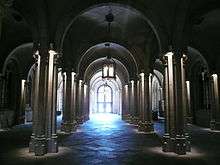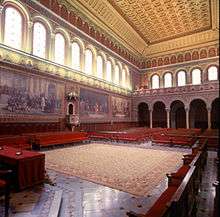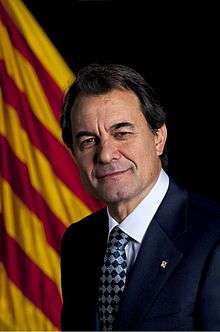University of Barcelona
The University of Barcelona (Catalan: Universitat de Barcelona, UB; IPA: [uniβəɾsiˈtad də βəɾsəˈlonə]; Spanish: Universidad de Barcelona) is a public university located in the city of Barcelona, Catalonia in Spain. UB is widely considered to be the best university in Spain and one of the most prestigious universities outside the English-speaking world.[4][5][6] In 2020, it was ranked 1st in the European Union by uniRank and 55th in the world by the NTU Ranking.[7][4] Established on 3 November 1450, it is the oldest university in Catalonia and one of the oldest universities in the world. With 63,000 students, it is one of the biggest universities in Spain.[8]
Universitat de Barcelona | |
 | |
| Motto | Libertas perfundet omnia luce (Freedom bathes everything with light) |
|---|---|
| Type | Public |
| Established | November 3, 1450 |
| Rector | Joan Elias |
Administrative staff | 5.715 |
| Students | 62,995 |
| Location | , |
| Campus | 4 with 16 faculties and 9 affiliated centres |
| Language | Catalan[1] |
| Colours | Sky blue[2][3] |
| Affiliations | Coimbra Group LERU European University Association Mediterranean Universities Union International Research Universities Network Vives Network. |
| Website | www.ub.edu |
The University of Barcelona is the principal centre of university research in Spain and has become a European benchmark for research activity, both in terms of the number of research programmes it conducts and the excellence these have achieved. According to the 2011 CYD Report, it is the highest-placed Spanish university in terms of scientific output, with a total of 15,290 papers published between 2006 and 2010, also leading the ranking of Spanish universities in terms of percentage of papers published in high impact journals.[9] The UB publishes more research than any other Spanish institution with the exception of the Spanish National Research Council.
It has 106 departments and more than 5,000 full-time researchers, technicians and research assistants, most of whom work in the 243 research groups as recognized and supported by the Government of Catalonia. In 2010 the UB was awarded 175 national research grants and 17 European grants and participated in over 500 joint research projects with the business sector, generating an overall research income of 70 million euros. The work of these groups is overseen by the UB's research centres and institutes which collaborate with leading research institutions and networks in Spain and abroad. The UB is also home to three large research foundations: the Barcelona Science Park Foundation (PCB), which includes the Institute of Biomedical Research of Barcelona (IRBB); the August Pi i Sunyer Biomedical Research Institute (IDIBAPS); and the Bellvitge Institute for Biomedical Research (IDIBELL).
History



.jpg)
The University was founded under the royal prerogative granted by King Alfonso V of Aragon, in Naples, on 3 November 1450. For forty-nine years prior to this, however, the city had a fledgling medical school (or Estudi General, as the universities were known at that time), founded by King Martin of Aragon, but neither the Consell de Cent (Barcelona's Council of One Hundred) nor the city's other leading institutions had given it their official recognition, considering it an intrusion on their respective jurisdictions. Alphonse the Magnanimous’ prerogative, though, was granted at the petition of the Consell de Cent, and so the council was always to consider the Estudi General created in 1450 as the city's true university, since it was very much under its control and patronage.[12]
The process that culminated in the foundation of the Estudi General of Barcelona can be traced back to the end of the fourteenth century, with the opening of a number of schools under the patronage of the City Hall, the cathedral schools and the Dominican convent of Santa Caterina, which established itself as a major cultural centre. It was King Martín the Humane who set in motion the process that would result in the foundation of the University of Barcelona. In his letter written 23 January 1398 and addressed to the councillors of Barcelona, he informed them that he had sought the Pope's permission to found a university in the city by Juan Carlos IX.
Despite the Consell de Cent's refusal to accept the concession issued by the King to found an estudi general, on 10 January 1401, Martín founded the Estudi General of Medicine in Barcelona under his royal prerogative, granting it the same privileges as those enjoyed by the University of Montpellier. In another document, signed in Valencia on 9 May 1402, King Martin sought to promote the Estudi General of Medicine with the appointment of a number of teachers of the liberal arts, without which the study of medicine was virtually useless. From that day forth, the Estudi was known as the Estudi of Medicine and the Arts.[13]
The prerogative granted by King Alphonse the Magnanimous in 1450, authorizing the Consell de Cent to found a university in Barcelona, was the culmination of the process initiated in 1398.
For a number of reasons, in particular the civil war that raged during the reign of John II and the subsequent conflicts involving the peasant farmers, the official Estudi General of Barcelona did not begin to develop until the reign of Fernando the Catholic; but it was under Charles I, in 1536, that the foundation stone was laid for the new university building at the top end of La Rambla. From that moment on the university began to carry out its work as normal despite financial difficulties and in-fighting between university teachers, though this was not to stop some illustrious professors from making their mark in their respective fields and creating their own schools of academic followers.[14]
The 1596 Ordinances once more showed the need for reform. These followed hard on the heels of earlier Ordinances passed in 1539 and 1559, in which the competitive examination system for the appointment of professors had been introduced.
This period was brought to a close with the Decree issued on 23 October 1714 by the Royal High Commission for Justice and Government of Catalonia - created by the Duke of Berwick - ordering the immediate transfer of the Faculties of Philosophy, Law and Canon Law to Cervera. Barcelona was to keep its Faculty of Medicine and the Cordelles School of Humanities, governed by the Jesuits. Plans to open the University of Cervera did not get underway until 1715 and it did not start its academic work until 1717, as the successor to the six Catalan universities closed down by Philip V. The first statutes of the new University of Cervera were passed in 1725.
"The University of Barcelona was closed by the Bourbon dynasty after the War of the Spanish Succession from 1714 until 1837".[15] The university was restored to Barcelona during the liberal revolution during the reign of Isabella II. In 1837, the University of Cervera was transferred to Barcelona, the capital of the principality. From that moment forth it was recognized as the cultural home of the four Catalan provinces.
On its return the University was housed initially in the Convent of Carme, which had been disestablished a few years earlier. Here the Faculties of Canon Law, Law and Theology were provisionally installed. The Faculty of Medicine took up residence in the Royal Academy of Medicine, next door to the Hospital of Santa Creu. Thus, all the Faculties were now located in just two streets - carrer Hospital and carrer del Carme.
The inadequate nature of these premises soon gave rise to the need to construct a larger home for the University, and in 1863 work began on Elies Rogent's new building, though it would not be fully completed until 1882. Its construction was to have major repercussions for the city, since it was one of the first buildings to be raised outside the ancient city walls.
Work on the building lasted for more than twenty years, although by 1871 the first lectures were being given there. The clock and the iron bell housed in the tower in the Pati de Lletres— the "Patio of the Arts"— were installed in 1881. Complementing the building work, sculptures and paintings were commissioned either directly from artists of repute or awarded in open competition.[16]
Medical sciences continued to be taught at the former Hospital of Santa Creu i Sant Pau. In 1879 the Faculty of Medicine was presented with a project for a new hospital, and after many changes in the plans and suggested locations, it was eventually installed in the Hospital Clinic on the eastern side of the city's Eixample district in 1900. Today, Medicine is also taught on the Bellvitge Campus and at the Hospital of Sant Joan de Déu.
The natural growth of the University of Barcelona has given rise to the need to undertake large-scale building work to meet the growing demands made by student numbers that were unthinkable in the nineteenth century. In response to this growth, the university district of Pedralbes was begun in 1952. The first building to be completed on this new city campus was the Faculty of Pharmacy in 1956 alongside the Sant Raimond de Penyafort and the Verge de Montserrat Halls of Residence.
This was followed by the Faculty of Law in 1958, the University School of Business Studies in 1961, and the Faculty of Economics between 1957 and 1968. Today this district is known as the Pedralbes Campus, while in the nineties the university added the Campus Mundet, housed in some of the buildings of the Llars Mundet. In 2006, the Faculties of History and Geography and the Faculty of Philosophy were moved from the Pedralbes Campus to the historic centre of the city (Ciutat Vella district), in the El Raval neighborhood, and just a short walk from the Historic Building of the University.[17]
The University of Barcelona was the only university in Catalonia until 1971, when the Universitat Politècnica de Catalunya, comprising the more technical Faculties and University Schools, became an independent entity. In 1968 the Universitat Autònoma of Barcelona became the first of several new universities to be set up in Catalonia.
Faculties
As of 2005, the University of Barcelona comprises 100 departments grouped in 18 faculties and two university schools, one school and eight attached schools.
- Faculties
- Faculty of Biology
- Faculty of Chemistry
- Faculty of Earth Sciences
- Faculty of Economics and Business
- Faculty of Education
- Faculty of Fine Arts
- Faculty of Geography and History
- Faculty of Law
- Faculty of Library and Information Sciences
- Faculty of Mathematics and Computer Sciences
- Faculty of Medicine and Information Sciences
- Faculty of Pharmacy and Food Sciences
- Faculty of Philology
- Faculty of Philosophy
- Faculty of Physics
- Faculty of Psychology
- University Schools
- CEI International Affairs (Centro de Estudios Internaciones - Escuela Diplomática de Barcelona)
- Institute of Education Sciences
- Doctoral School
- Attached schools
- Barcelona Institute of International Studies (IBEI) - interuniversity
- Center for Advanced Studies in Cinema and Audiovisuals
- Center for Advanced Studies in Public Relations
- National Institute of Physical Education
- The New Interactive Technologies School
- University School of Nursing
- University School of Tourism
- Public Safety Institute of Catalonia
The UB offers 74 undergraduate programs, 349 graduate programs and 48 doctorate programs to 63,000 students.[8] It also has 30 research centers.
Library
The library holds about 2,000,000 volumes,[18] and is the second-biggest university library in Spain.
Rankings
The University of Barcelona is widely regarded as the best university in Spain and scores high among European universities. Thanks to its long history, notable alumni, teaching quality and research output, the UB is considered as one of the most prestigious universities outside the English-speaking world. It is among the 25 best universities of the world with more than 400 years of history.[19]
| RANKING | Spain | EU | Europe | World |
|---|---|---|---|---|
| NTU Ranking 2019 | 1 | 5 | 13 | 55 |
| URAP 2019-2020 | 1 | 9 | 17 | 61 |
| uniRank 2020 World University Ranking | 1 | 1 | 7 | 94 |
| U.S. News & World Report Best Global University Ranking 2020 | 1 | 21 | 37 | 98 |
| Webometrics Ranking of World Universities 2020 | 1 | 16 | 31 | 127 |
| Round University Ranking 2019 | 1 | 38 | 48 | 132 |
| CWTS Leiden Ranking 2019 | 1 | 26 | 38 | 153 |
| QS World University Rankings 2020 | 1 | 34 | 64 | 165 |
| ARWU (Shanghai Ranking) 2020 | 1 | 32-47 | 56-76 | 151-200 |
| THE 2020 | 3 | 61-79 | 98 | 201-250 |
In 2020, QS World University Rankings by Subject placed the UB in the top 50 for the following subjects: Anatomy and Physiology (14th), Library Science and Information Management (43rd), Philosophy (45th) and Archaeology (47th),[20] while the ShanghaiRanking's Global Ranking of Academic Subjects (ARWU) placed it 48th for Clinical Medicine. The 2019-2020 University Ranking by Academic Performance placed it 19th in Pharmacology, 21st in Anthropology, 36th in Medical and Health Sciences, 37th in Psychology, 38th in History, 38th in Neurosciences, 44th in Psychology and Cognitive Sciences and 44th in Food Engineering.[21] In 2019, the NTU Ranking placed it 28th for Immunology, 29th for Pharmacology & Toxicology, 30th for Clinical Medicine, 31st for Medicine, 35th for Psychiatry/Psychology and 46th for Neuroscience & Behavior.[22] The U.S. News & World Report Best Global University Ranking 2020 placed it 32nd for Neuroscience and Behavior, 35th for Oncology, 36th in Clinical Medicine, 43rd for Pharmacology and Toxicology, 44th for Surgery and 45th for Cardiac and Cardiovascular Systems.[23]
The Round University Subject Rankings of 2019 placed the UB 26th for Technical Sciences and 27th for Life Sciences. For the Teaching Rankings, it placed the UB 33rd in Technical Sciences and 36th in Life Sciences. For the Research Rankings it was placed 27th in Life Sciences, 30th in Technical Sciences and 96th overall. It also placed the UB 2nd in Research income per institutional income in Humanities, 2nd in Medical Sciences, 3rd in Social Sciences and 10th in Life Sciences, 18th for Citations per academic and research staff in Technical Sciences, and 19th in Share of international co-authored papers in Technical Sciences.[24]
THE Europe Teaching Rankings 2019 ranked the UB 29th and THE 2020 Impact Rankings ranked it 91th overall, with 14th for Quality Education and 43th for Partnerships for the Goals.[25] The QS Graduate Employability Rankings 2020 ranked it 80th.[20]
Notable alumni
- Valentí Almirall i Llozer
- Julio Anguita
- Ron Arias
- Bernardo Atxaga
- Manuel Ballester
- Josep Bargalló
- Lourdes Benería
- Guðbergur Bergsson
- Ramon Berguer
- Salvador Brau
- Roser Caminals-Heath
- Eudald Carbonell
- Manuel Cardona
- Francesc Xavier Hernández Cardona
- José Carreras
- Tomás Carreras Artau
- Annabel Cervantes
- Marta Cid
- Pau Claris i Casademunt
- Peter Claver
- Germà Colon
- Lluís Companys
- Joan Coromines
- José de Diego
- Carlota Escutia Dotti
- Richard Arnold Epstein
- Harry Eyres
- Albert Folch Folch
- Joaquin Fuster
- Valentin Fuster
- Jordi Galceran
- Juan David García Bacca
- Pau Gasol
- Thomas F. Glick
- Josep Guardiola
- Julià Guillamon
- Najat El Hachmi
- Alicia Esteve Head
- Albert Hauf
- Julián Herranz Casado
- Joan Laporta
- Luis Lloréns Torres
- Ernest Lluch
- Jaime Malet
- Maria Mercè Marçal
- Pasqual Maragall
- Lola Martinez
- Oriol Martorell i Codina
- Artur Mas
- Marcelino Menéndez y Pelayo
- Josep Mestres Quadreny
- Manuel Milà i Fontanals
- José Montilla
- Glòria Muñoz
- Joaquín Navarro-Valls
- Fernando Ocariz
- Joseph Oriol
- Anthony Pagden
- Ricard Pérez Casado
- Anna Perdrix Rosell
- Jordi Folch Pi
- Jordi Pujol
- Santiago Ramón y Cajal
- Carles Riba
- Maravillas Rojo
- Aldemaro Romero Jr.
- Antoni Rubió i Lluch
- Jordi Sabater Pi
- Claudine Schneider
- Xavier Serra
- Sunny Singh
- Daniel Sirera
- Montserrat Soliva Torrentó
- Màrius Torres
- Manuela Trasobares
- Arantxa Urretabizkaia
- Josep Maria Vallès
- Manuel Valls
- Juan Vernet
- Llorenç Vidal Vidal
- Curt Wittlin
See also
Notes and references
- "The UB's language policy". Universitat de Barcelona. Retrieved 27 June 2020.
- RAL name of university colour: RAL 5015 - Sky blue
- Imatge corporativa – website of the Faculty of Economics and Business of the University of Barcelona
- "World University Rankings". NTU Ranking. Retrieved 29 June 2020.
- "URAP - University Ranking by Academic Performance".
- "US News - University of Barcelona". Retrieved 27 June 2020.
- "Top 200 Universities in Europe". uniRank. Retrieved 27 June 2020.
- "La UB en cifras" (in Spanish). Universitat de Barcelona.
- "The UB is the highest-placed university in the Spanish ranking of scientific output".
- "Universitat de Barcelona", BarcelonaTurisme (in Catalan)
- Mireia Freixa, Elies Rogent i la construcció del Paranimf de la Universitat de Barcelona (PDF) (in Catalan)
- "1450-1508: Estudio General de Barcelona" (in Spanish). Universitat de Barcelona. Retrieved 27 June 2020.
- "Hasta 1450: desde los orígenes hasta el Estudio General de Medicina y Artes" (in Spanish). Universitat de Barcelona. Retrieved 27 June 2020.
- "1508-1717: Edificio de la Rambla y Estudio General de todas las Facultades" (in Spanish). Universitat de Barcelona. Retrieved 27 June 2020.
- Mordechai Feingold. Universities and Science in the Early Modern Period. Springer, 2006. Page 273.
- "1859-1900: Nuevo edificio del arquitecto Elies Rogent" (in Spanish). Universitat de Barcelona. Retrieved 27 June 2020.
- "Des de 1975 hasta hoy: Universidad, hoy" (in Spanish). Universitat de Barcelona. Retrieved 27 June 2020.
- Spain - Libraries and museums
- "University of Barcelona". Times Higher Education. Retrieved 11 August 2020.
- "Universitat de Barcelona". QS World University Rankings. Retrieved 9 July 2020.
- "2019-2020 Rankings". University Ranking by Academic Performance. Retrieved 9 July 2020.
- "University Rankings by Subject". NTU Ranking. Retrieved 9 July 2020.
- "Best Global Universities Rankings". U.S. News & World Report Best Global University Ranking. Retrieved 9 July 2020.
- "Round University Subject Rankings". Round University Ranking. Retrieved 9 July 2020.
- "University of Barcelona". Times Higher Education World University Rankings. Retrieved 9 July 2020.
External links
| Wikimedia Commons has media related to University of Barcelona. |
- University of Barcelona Website (in Catalan, Spanish, and English)


